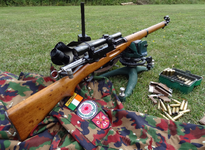- Messages
- 277
- Reactions
- 271
- Thread Starter
- #21
Follow along with the video below to see how to install our site as a web app on your home screen.
Note: This feature may not be available in some browsers.
@tac good to know about swiss. I do have a 96/11 i enjoy shooting. Mike

What is that big green thing under the K-31?You'll find that the best website for Swiss schtuff is swissrifles.com. Piérre here is the daddy of it all, and his son, Latigo, now runs most of the show, including the Swiss Products company in Kalispell MT. Grafs and Brownells are no longer distributors, and SP are sold direct to the customer, cutting out a whack of $$$. The new diopter sight system for the K11/G11 et al is a wonder to behold, if you are into that kind of shootment. Both Piérre and Latigo post on gunboards.com. The sites are both frequented by Swiss national shooters as well, to bring an authentic flave to it all...
View attachment 507120
What is that big green thing under the K-31?I know in Switzerland the shooters use rests.
Here in the US we are sling shooters. How about you @tac ?
I modified my K-31 with a 6 O'clock sling swivel.

Would you mind clarifying why no bumping except for bolt?
Mine too... I have it mounted to a Harbor Freight grinder stand along with a small vice so I can move it anywhere around the Mygrain Silo. I have tried a couple other single stage presses, and I have a Lyman turret set up that is great, but I always seem to use that little partner more than anything else.My first press was a partner press bu rcbs
I have since acquired better tools but I still use that press for priming brass cases. I think that little press would do most of my reloading if it was my only press. You dont need to have the best equipment to start.
The rock chucker does one thing much better than that partner press and that is resizing military brass. I buy a lot of lake city once fired 308 brass and that stuff takes some serious work to get it back into dimensions. The rock chucker is also a lot better at forming brass like for Wildcats. I use two rock chuckers as my primary presses.Mine too... I have it mounted to a Harbor Freight grinder stand along with a small vice so I can move it anywhere around the Mygrain Silo. I have tried a couple other single stage presses, and I have a Lyman turret set up that is great, but I always seem to use that little partner more than anything else.
I did just get a Rock Chucker2 at the ARPC show last month.. I like it a lot!